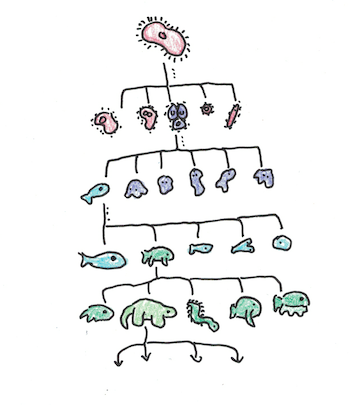
Some ideas are so powerful and general, that once you learn them you start seeing them everywhere. Today I’d like to discuss one of those ideas: evolution by natural selection.
Evolution by natural selection was one of the greatest intellectual triumphs of the last thousand years. The great diversity of life, including human beings, is the outcome of a rather simple process, repeated a tremendous number of times over billions of years.
Yet biological evolution is just a principle example of this pattern, it’s not the only place it applies. If you take the analogy more approximately, it can apply to far more things and allow you to reason about culture, ideas, technology and more.
Evolution by Natural Selection
Commonly shortened just to “evolution”, evolution by natural selection is a relatively simple model. To have it, you really only need three things:
- A mechanism for creating copies with high-fidelity (aka replication).
- A mechanism for changing the copies slightly (aka mutation).
- Different copies should persist and copy at varying rates (aka fitness).
Once you have these three things, the outcome is that, over time, the copies that survive and replicate better will multiply, and “ineffective” copies will die off. What starts as a simple, random process, can create a ratchet leading to better and better versions.
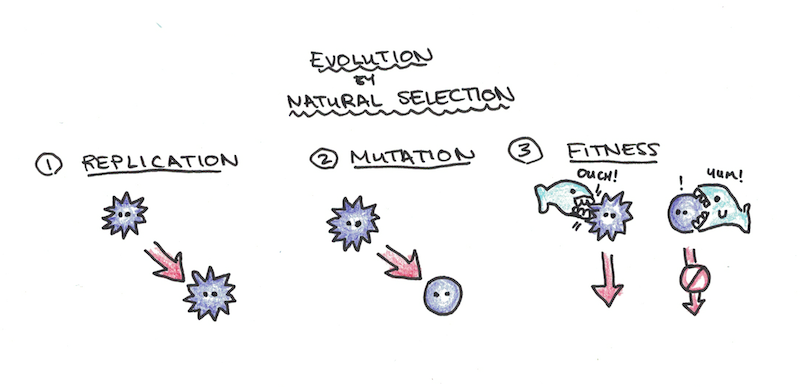
Evolution is such a popular idea, however, that it risks being used to casually without really understanding the mechanism by how it works. Consider a popular false analogy I first heard called out by Eliezer Yudkowsky.
Corporations evolve. They have protocols and products. Those that do well survive and grow. Those that don’t do well go bankrupt. Therefore the growth we’ve seen in companies is due to corporations evolving.
However, if you look through the above list of preconditions, you can see that it can’t possibly be the case that corporations evolve via natural selection. Corporations, for instance, don’t create copies of themselves with high fidelity. Apple doesn’t spawn mini Apple’s that are the same in every way plus a few mutations.
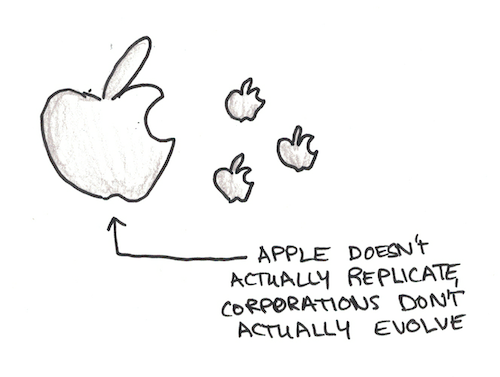
In order to really understand a mental model, it’s not enough to see it in more places. You also have to recognize places it doesn’t apply, even when it seems to. Just because the weird knots on a tree stump look like a smiling face doesn’t mean the tree is happy, and thinking it does just means you understand happiness less.
What Actually Evolves?
A good test of your understanding of natural selection isn’t to just see evolution everywhere, but to ask yourself what, specifically, is undergoing selection?
Many people, when asked about what evolves, will say species. Human beings evolve to beat out other species, rising above apes, Neanderthals and other animals.
This, however, is false. To see why, again, look at the above pattern. What actually replicates? Not species at all. A species doesn’t replicate itself, and so it can’t be the actual unit undergoing selection.
Another tempting answer is to say that individuals are what replicate. You and I are individuals, and so we’re the basic unit that is replicating, mutating, surviving and evolving.
This, it turns out, is also likely false. To understand why, again think to the preconditions. You don’t actually make high-fidelity copies of yourself. Your children resemble you and inherit much from you, but they also inherit much from their other biological parent.
A more correct answer, is to say that genes themselves are the basic object that replicates. Species, societies and even you and I are merely vehicles for the endlessly replicating genes themselves. An individual is nothing more than a collection of genes that survived better by grouping together than by existing separately in the primordial goop.
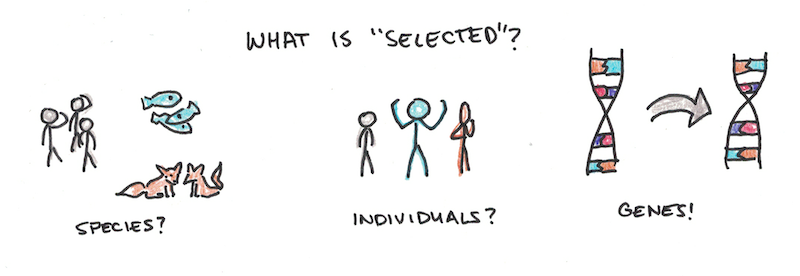
The implications of the gene-centered view of natural selection are broad, and I’ve discussed them in my book club episode covering The Selfish Gene.
What Else Evolves?
Biological natural selection is the clearest and most unequivocal example of this pattern. However, depending on how strictly we enforce the definition, there are many other places where this idea seems to apply, at least partially.
One example is cultural evolution, as proposed by Joseph Henrich. This idea says that human beings are unique because we not only evolve biologically, but our cultural practices work on an analogous system of evolution which happens to be much faster.
To see if this pattern really fits, let’s look again at the core tenets:
- Replication: People are expert copiers, in particular we copy people/groups we see as prestigious, often replicating with fidelity aspects of a behavior ritualistically, without a clear rationale.
- Mutation: While we’re expert copiers, we’re not perfect. Every once in awhile a behavior will be learned incorrectly. Whole tribes of people have gotten cut off of basic technologies, such as fire, when information about how to make one gets corrupted or lost.
- Fitness: Behaviors have different success rates. These different success rates directly induce differences in replication because those less successful die of. In addition, because we tend to copy prestigious individuals, who by definition are more successful, successful behaviors replicate much more quickly than by survival of their practitioners alone.
In this sense, the evolving unit isn’t a gene or individual, but an cultural practice. Henrich argues that we have evolved to expect culture. Our brain, rather than evolving the best behaviors itself, seems to have left open slots where culture can be absorbed. Language, tools, rituals and religions are all part of our cultural evolutionary history.
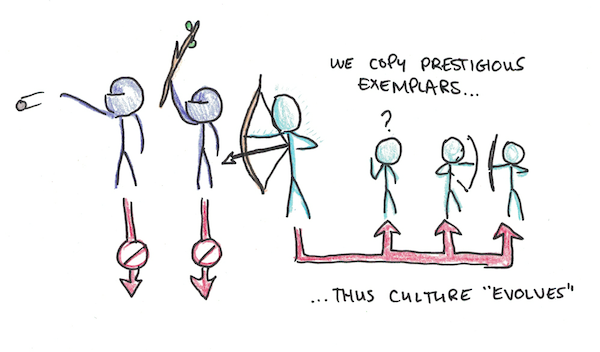
Cultures may not be the only thing that evolves, via prestige networks. Richard Dawkins, in The Selfish Gene, first proposed the concept of a “meme.” Unlike cultural evolution from copying prestigious exemplars (which would seem to benefit the host), memes can be parasitic, evolving because a certain idea encourages its replication and thus becomes prevalent even if it is neutral or detrimental to the host.
Religions that encourage evangelism, for instance, would have greater memetic fitness, even if missionary work didn’t benefit the individuals themselves. This is because if your religion is best kept to yourself, it is unlikely to spread as far as one which encourages you to convert believers.
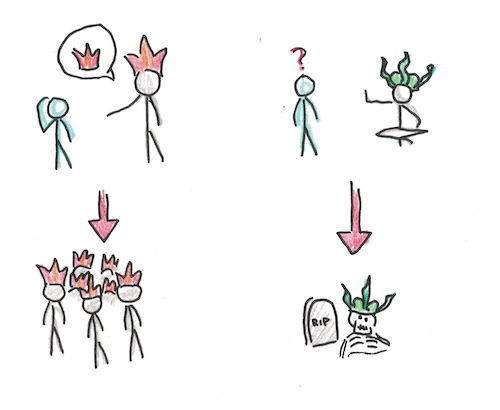
Applying Evolution by Natural Selection to Your Life
There’s a few ways you can use this mental model in your own thinking.
First, you can ask yourself whether a system has the propensity to evolve over time. Is there faithful replication? Mutation? Fitness? Then you might have a system which ratchets up towards more successful replicators in the future.
Second, you can also see how this can be used to solve problems that you’re unable to solve through reason alone. Programmers, for instance, can use this directly in the form of genetic algorithms. Create a bunch of candidate approaches, mutate them, replicate them and keep only one that works best, then repeat.
A smaller-scale version might be present in your own work as you learn. Trial-and-error isn’t necessarily evolutionary in the sense that you’re faithfully copying your approach and trying things purely randomly, but it can result in improvements even when you don’t fully understand them.


 I'm a Wall Street Journal bestselling author, podcast host, computer programmer and an avid reader. Since 2006, I've published weekly essays on this website to help people like you learn and think better. My work has been featured in The New York Times, BBC, TEDx, Pocket, Business Insider and more. I don't promise I have all the answers, just a place to start.
I'm a Wall Street Journal bestselling author, podcast host, computer programmer and an avid reader. Since 2006, I've published weekly essays on this website to help people like you learn and think better. My work has been featured in The New York Times, BBC, TEDx, Pocket, Business Insider and more. I don't promise I have all the answers, just a place to start.